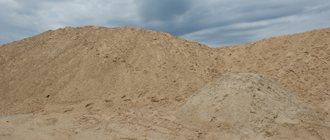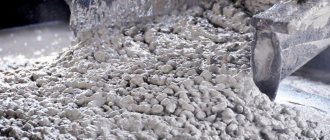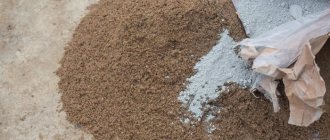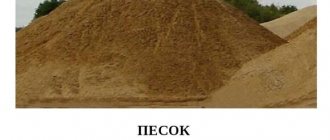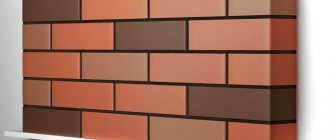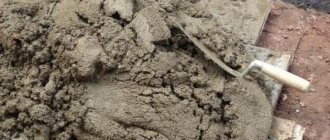River washed sand is a mineral sedimentary rock consisting primarily of quartz and mined from river beds. And not only deep-water ones, but also dry ones (not to be confused with quarry mining). Compared to other types of natural origin, it is distinguished by the almost complete absence of light impurities and homogeneity. In addition to cleanliness, it also has other features, for example, a rounded geometric shape. However, the economic feasibility of use in private construction is often disputed. Therefore, when choosing a material, it is advisable to learn more about its properties.
Characteristics of river sand GOST 8736 93
The material is most widely used in the construction industry. Therefore, compliance of its characteristics with regulations is so important. The document relevant to management, GOST 8736-2014, summarizes the information contained in previous editions. Classifying characteristics are described here, links to other GOSTs are given, and acceptable values for the amount of impurities and other parameters are indicated. Find out about the rules for selecting the composition of concrete according to GOST 27006-2012 at this link.
The product raised from the bottom of the river differs significantly from lake or sea products. If the quality of the latter is considered the best, then the composition of the lake one includes, as a rule, a considerable amount of organic matter, silt, clay, etc.
Chemical composition
Sand is a pure substance only if it is quartz, but even then the impurities will be at least 0.1% of the total mass. The river variety, even after cleaning, contains foreign inclusions, including harmful ones. However, the basis of the composition remains silicon dioxide (SiO2).
GOST regulates the permissible content of harmful chemicals (by volume and weight):
| Substance | No more |
| Varieties of quartz dissolved in alkalis | 50 mmol/l |
| Sulfur, sulfides, sulfates | 1% |
| Pyrite | 4% |
| Mica | 2% |
| Inclusions of halogens and water-soluble chlorides | 0.15% |
| Coal | 1% |
This takes into account the activity of radionuclides, the value of which, permissible for civil engineering without restrictions, is up to 370 Bq/kg. The maximum value at which sand is used only for the construction of roads outside populated areas is up to 1500 Bq/kg. Material with an intermediate radioactivity value (370 – 750 Bq/kg) is used in industrial construction with some restrictions.
As a rule, “black” sands are radioactive.
Classification by fraction size - fineness modulus
The size of the fractions, as well as their ratio in the total mass, are significant indicators. After all, the features of the material’s use largely depend on them. Therefore, it is based on them that the division of sand, including river sand, into categories is built:
- Washed sand is a loose mineral that has undergone minimal cleaning, the grains of which usually range in size from 0.5 to 5 mm (grade 2). A widespread variety in nature and on the market.
- Enriched coarse-grained - with an improved composition, cleared of dust, clogging and clay inclusions (grade 1).
- Fractionated – divided into clear fractions (1st grade).
Fractionated sand (FS) is comparable in its parameters to quartz. That is, clay and clogging impurities are excluded here. Therefore, it is used for the manufacture of critical elements of reinforced concrete structures, as well as for decorative purposes. At the same time, except for the grain sizes established by GOST, no other classification of this subspecies is carried out. FP fractions are distinguished:
- 2.5 – 5;
- 1.25 – 2.5;
- 0.63 – 1.25;
- 0.315 – 0.63;
- 0.16 – 0.315 mm.
Mixing of varieties is carried out in agreement with the consumer. For example, fine-grained is mixed with coarse-grained to increase specific gravity. The production of PP with fractions not specified in the standard is also possible after discussion with the customer. Extraneous inclusions of grains of unplanned size should not exceed 5% in both directions.
Classification of sand according to GOST (any class and category) is carried out into groups to which the particle size module corresponds:
| Group name | Size module |
| Increased size | 3.1 – 3.5 |
| Large | 2.6 – 3 |
| Average | 2.1 – 2.5 |
| Small | 1.6 – 2 |
| Very small | 1.1 – 1.5 |
| Thin | 0.8 – 1 |
| Very thin | up to 0.8 |
In addition to the size of the fraction, other material parameters are of significant importance. For example, compaction and filtration coefficient, as well as density and weight. Knowledge of these values is especially important for the consumer when purchasing, storing, and laying sand.
Sand of the middle fraction is considered universal.
Compaction factor
The compaction coefficient of construction and river sand is an indicator that describes the ratio of the thickness of the laid layers to the standards. Simply put, it shows how many times the existing mass will be compacted during transportation or compaction. The recommended value is indicated in the technical process regulations, if we are talking, for example, about the production of reinforced concrete products.
Unlike the compaction coefficient of crushed stone, this indicator is calculated, as a rule, based on the generally accepted value of 1.15. They are used mainly for design calculations, as well as to verify the integrity of the supplier. To do this, measure the volume brought and multiply it by a coefficient. If everything is correct, the result should be the purchased volume.
The highest compaction coefficient is found in sand obtained by crushing rocks. After all, the sharp edges of grains of sand are quite fragile and break during transportation and compaction.
Filtration coefficient
The filtration coefficient indicates the rate of passage (percolation) of water through the thickness of the mineral. It is directly dependent on the purity of the sand mass and the size of the fraction. It is measured, as a rule, in meters and days (m/day) with a hydraulic slope equal to 1.
This indicator affects the scope of application of the material, so its value is quite important. However, it is not easy to calculate it yourself, because without a special device (such as “KF-00M”) the accuracy of the measurements is questionable. River sand, being the cleanest, is characterized by high filtration rates - 5 - 8 m/day. This explains its use as a drainage fill, as well as a filter backfill for aeration wells, settling filters, etc.
Filtration capacity mainly depends on the presence of clay inclusions. Their presence is determined “tactually” - by tightly squeezing the dry composition with your hand. High-quality river sand will never take the shape of a hand, but will immediately crumble.
Density (bulk) and weight
The density of a substance is the ratio of mass (for example, grains of sand) to the occupied volume. Applicable to bulk materials, this value is determined only in the laboratory. Indeed, in “field” conditions it is impossible to calculate the size of the interfractional gaps and the amount of foreign impurities. The result is the true (specific) density of the mineral, which does not take into account these significant factors. It depends only on the mineralogical composition of sand grains. For river sand, the value corresponding to GOST is 2.4 – 2.5 g/cm3.
In real conditions, the “bulk” density is calculated, which differs significantly from the specific values. It is easy to determine by taking a scale and a container of a certain volume. The bulk density of washed dry sand of river origin is in the range of 1.5 – 1.7 g/cm3. As humidity increases, this parameter first decreases and then increases significantly due to the replacement of the air gap with water. This material will tell you about the density of M400 cement.
Volume, specific gravity - parameters similar to the bulk and specific density of the product, but not considered by the current GOST.
Table of bulk density (volumetric weight) of different types of sand mass:
| Material | Value kg/m3 |
| Construction (according to GOST) | 1490 – 1520 |
| Dry Loose | 1430 – 1450 |
| Dry compacted | 1670 – 1690 |
| Wet | 1910 – 1930 |
| Wet compacted | 2530 – 2550 |
| River | 1600 – 1650 |
| Quartz | 1640 – 1660 |
| Career | 1490 – 1510 |
The spread of values is due to the fact that even in one container the humidity and compaction of sand is uneven. Technologically sound density is obtained by mixing different varieties.
Varieties
In the construction field, quarry sand is classified according to the size of the sand grains and the processing method. Taking into account the grain size, the material in question takes the following forms:
- small
- average
- large grains of sand
For material with fine grains, their size cannot be more than 2 mm. Medium-grained sand is characterized by dimensions of 2-2.8 mm. Granules of a large product can reach 5 mm. In addition, the material is classified according to the processing method into seeded and alluvial.
To obtain seeded quarry sand, a sifting method is used using a system of special sieves. As a result, stones and other large inclusions are removed from it. Alluvial is obtained by the method of washing. In this case, hydromechanical equipment is used. As a result of this treatment, clay and soil impurities are removed from the composition of quarry sand, which improves the chemical composition.
Based on grain composition, they are divided into the following types:
- quartz;
- mica-quartz;
- feldspar;
- limestone;
- dolomite.
In the field of construction, quarry stone, which arose during the destruction of mountain quartz, is in great demand.
Production
Sand is extracted from dry river beds in the same way as from quarries. That is, excavators, graders, mining dump trucks. The difference lies in the unnecessaryness of multi-stage purification and enrichment activities. Although such a product is usually of worse quality than one raised from the bottom of the river. Read about the types and characteristics of building blocks in this article.
The most expensive delivery method is road transport, but it is also the most efficient. Ordering one large car is cheaper than two small ones.
A full-flowing river not only cleanses the mineral from silt, clay, organic matter, and other light impurities. Moving water also sorts it naturally, qualitatively separating the fractions. Final cleaning is carried out during the extraction process, consisting of the following stages:
- Actually, lifting from the bottom is carried out using a “dredger” - a technical vessel. It can be equipped with a “scooper” (for compacted sand) and (or) a powerful pump (silt sucker) with a large diameter hose.
- The semi-liquid mixture is unloaded onto a cargo receiving barge equipped with devices for discharging water, or directly onto the shore (shore structures).
- Here the sand mass is washed as many times as required by the technical process, based on the characteristics of the deposit. As a rule, the product from the bottom of the river does not require very complex technical procedures for purification and enrichment.
- Then it is dried, creating special conditions or simply storing it in the open air.
- Then, from one or more mined batches, depending on the regulations, samples are taken for laboratory analysis and testing.
- Only now the river is transported to the storage site, further processing (processing) or to the customer.
The product is transported by barges, railway dump trucks or vehicles. In the first case, the landing stage is often skipped, which reduces the price of the material. However, transportation by water does not contribute to compaction, which means that the volume is obviously overestimated.
Where is the substance used?
The areas of application of river sand are associated with its advantages - purity and high filtering ability. The rounded shape of the grains of sand is not considered an advantage of the material, because it negatively affects its adhesive properties. Therefore, such a product settles quickly, and solutions filled with it must be constantly stirred. However, it is used wherever a high-quality filler is needed:
- In everyday life - as interior or facade decor, contents of sandboxes, etc.
- In industry - as a component of glass, ceramic and other materials and products.
- In agriculture - for raising the level or replacing part of the soil, installing drainage, filling paths, etc.
- In construction - as a filler for mortars, reinforced concrete products, backfills for pits, as well as support, leveling and drainage fills. In construction, clay mortar is also used for laying stoves.
Additionally, after sifting and tinting the river sand, they create full-fledged objects of art.
Application in construction for bricklaying
Despite the roundness of the grain and the high price, river grain is recommended for use in all areas of construction. After all, purity and uniformity of the composition are useful, no matter how it is used. For example – for filling:
- Masonry mortars (for bricks, gas blocks), characterized by the absence of impurities that leave indelible marks on the surface of the cladding.
- Mortars for screeds and plasters, convenient, durable, reliable. After all, because the number of foreign inclusions is reduced to a minimum, river water is almost completely inert. Therefore, its interaction with cement, as well as plasticizing, water-repellent and other additives, is predictable.
Fine-grained sand is well suited for addition to finishing materials, and coarse-grained sand is well suited for addition to concrete and reinforced concrete products. The filtration rate of the product determines its use for filling roads, foundation pads, drainage fields, and wells. After maximum cleaning and sorting, sand is added to decorative plasters and paints. For example - “Bark beetle”. Find out about the use of quicklime in construction here.
Factors influencing density formation
One of the physical characteristics of sand, its degree of density, determines how much volume the same amount by weight will occupy. Sand density, kg/m3, depends on the following criteria:
- , that is, grain sizes: fine-grained sand fractions are denser, larger ones have a smaller size.
- and porosity of the material: this criterion shows the volume of voids in the granular substance. The reduction in looseness occurs due to several factors, such as: dynamic impacts and vibrations, moisture saturation, pressing, etc.
Sand density, kg/m3 is indicated in the table:
- Humidity indicators - the bulk density of sand (kg per m3) is formed based on humidity conditions: when it increases to 10%, the volume increases in proportion to the decrease in density; with moisture saturation up to 20%, air is displaced by water and the weight of one cubic meter increases. The density of river sand, kg m3, judging by the table, is higher than similar materials.
- Impurity content: the presence of particles of dust, clay, mica, crushed stone, gypsum, stone chips, etc. will definitely affect the characteristics and properties of the bulk material. Alluvial sand (purified with water) becomes much cleaner and a little more expensive.
Is it possible to get quartz from river sand?
The purpose of quartz is associated with high performance and decorative qualities. For example, it is used to fill hourglasses, and is also used as an abrasive, decoration, and a component of glass or porcelain. Its small volumes – both in nature and on the market – contribute to its high price. Therefore, attempts to obtain it from ordinary sand mass do not stop.
The material is obtained as follows:
- repeatedly sift the pure product from the bottom of the river through different sieves, achieving grain uniformity and the complete absence of clay;
- washed with a weak solution of hydrochloric acid, removing iron oxide, completing mechanical cleaning;
- washed repeatedly with water (for example, with a Gresley and Ruga machine);
- Dry thoroughly in the sun or oven.
The product obtained by this method is worse and dirtier than real quartz sand, but close to it.
Degree of density and ability to accumulate moisture
The specific mass is based on the method of its installation. There are several stages of crimping:
- classic occurrence;
- compacted by workers and specially compacted;
- bulk.
The specific gravity of 1m3 of sand will be significantly greater if the material was wet.
The percentage of moisture affects the volume indicators, but they are not so significant. Material that was stored at sub-zero temperatures and with high moisture content will weigh 15% more.
How to ignite
The characteristic features of calcined are chemical inertness and “zero” humidity. From these properties follows the scope of application - construction, abrasive (sandblasting) processing of metals and other materials. Calcined sand is ideal for working in winter (for laying paving slabs), because there is nothing there to freeze.
It is calcined in electric or other ovens at different temperatures. For example, 150 - 200°C is enough for dehydration, which can be achieved at home - on the stove, in the oven. However, the release of the mineral from carbonate rocks (lime, magnesite) is possible when the temperature rises to 700 – 800°C. In this case, the impurities are “burnt”, becoming inert to chemical influences. Check the purity of the product by pouring vinegar over it and listening to the “hissing” of the carbonates. Read about the density of marble and the formula for the strength of marble chips here.
Coloring river sand
The dry, purified product is tinted, usually for decorative purposes. For example, to create applications, sidewalk paths, colored containers, etc.
Several materials and two techniques are used:
- Tempera dry water-soluble paints or crushed crayons are mixed with river sand in precise proportions. In this case, use a sealed container and then sift it.
- Alcohol (or other) inks and liquid food coloring require thorough long-term mixing and drying.
The absence of soiling can be achieved only by using liquid coloring pigments.
